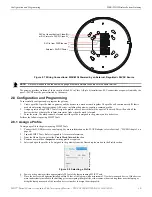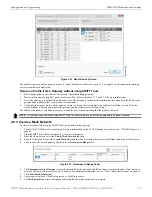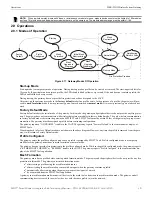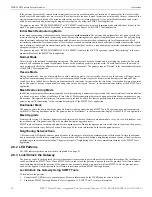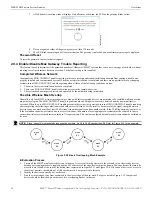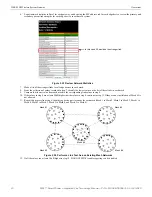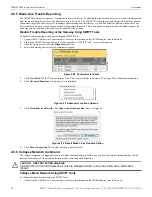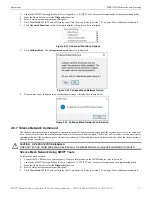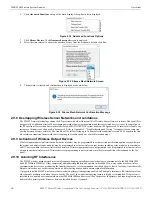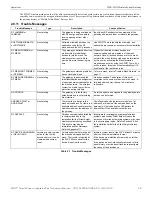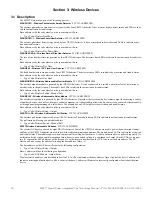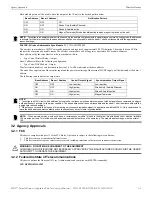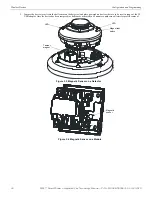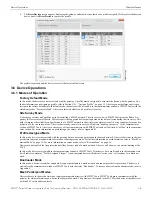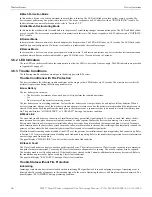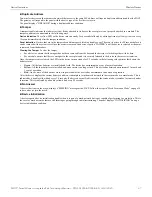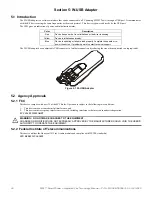
SWIFT® Smart Wireless Integrated Fire Technology Manual —
P/N LS10036-000SK-E:G 4/13/2020
29
Operations
WSK-WGI Wireless System Gateway
The SWIFT wireless mesh network will be able to automatically detect and avoid certain types of in-band channel interference (often
caused by two-way radios) by using an alternate channel set. The system will log detection and avoidance of this kind of interference in
the gateway history as “Walkie Talkie Mode” Entry or Exit.
2.9.11 Trouble Messages
Trouble Message
Type
Description
Course of Action
RF JAMMING or
JAMMING
Non-latching
The gateway is being overloaded
with RF energy and is unable to
receive messages from other
devices.
Identify any RF emitters in close proximity of the
gateway and remove them or relocate the gateway.
SOFTWARE MISMATCH
or SOFTWARE
Non-latching
Software mismatch between the
application code for the RF
processor and the SLC processor.
Use SWIFT Tools to identify the mismatch, and
update the processors as necessary for compatibility.
RF MESH FORMING or
RF MESH
Non-latching
The gateway and attached devices
are searching for additional
devices to join the mesh. The
wireless system is not able to
provide fire protection during this
time.
Wait until all desired wireless devices are
communicating and are members of the mesh
network. Once all desired devices are in the mesh
network, the mesh forming mode can be terminated
by the user by activating the Mesh formation
magnetic sensor or by using the SWIFT Tools. If no
action is taken, this mode will automatically exit 10
minutes after the last device joins.
RF MESH NOT FORMED
or RF MESH
Non-latching
The gateway contains a profile but
has not formed a mesh.
To form a mesh, refer to“Create a Mesh Network” on
page 17.
RF MESH REFORMING or
RF MESH
Non-latching
The gateway is performing the
initial identification and assignment
of optimal communication paths for
the mesh network. The wireless
system is not able to provide fire
protection during this time.
No action needed. The duration of this event
correlates to the number of devices in the mesh. A
fully loaded mesh may take up to 5 minutes to
restructure.
NO PROFILE
Non-latching
The gateway is in the factory
default state and is not providing
fire protection.
A profile needs to be assigned to the gateway before
a mesh can be formed.
ADDRESS FAULT or
ADDR FAULT
Non-latching
There is either a device in the
mesh set to address 0 or there is a
duplicate address used for another
wireless module at the address of
the gateway.
The offending device (detector or module set at
address 0 or module at the same address as the
gateway) will be indicating the LED pattern for
address fault. Find and resolve that device.
RF OVERLAP
Non-latching
Wireless communication reliability
is compromised due to the
installation limits of Silent Knight
wireless systems being exceeded.
This trouble may also be
interpreted as Max Gateways.
Refer to Appendix C.1.
Investigate for overlapping or adjacent wireless
systems produced by Silent Knight. Reduce the
instances of overlap by removing systems, or devices
in the overlapping region. Refer to Section 2.9.8 on
the installation limits for the Silent Knight wireless
system.
RF DEVICE NO ANSWER
or DEV NO ANS
Latching trouble; remains
active for the first 90
seconds before it can be
cleared with a system
reset.
A wireless device that was part of
the mesh has dropped from the
mesh. The trouble is reported at
the FACP 90 seconds after the
device drops from the mesh.
Initiate a system reset at the FACP at least 3 minutes
after the trouble was initiated to clear.
If the device was intentionally removed, no further
action is needed.
If the device was not intentionally removed, refer to
panel history or active panel troubles to investigate
the cause of the disturbance.
Table 2.1 Trouble Messages

